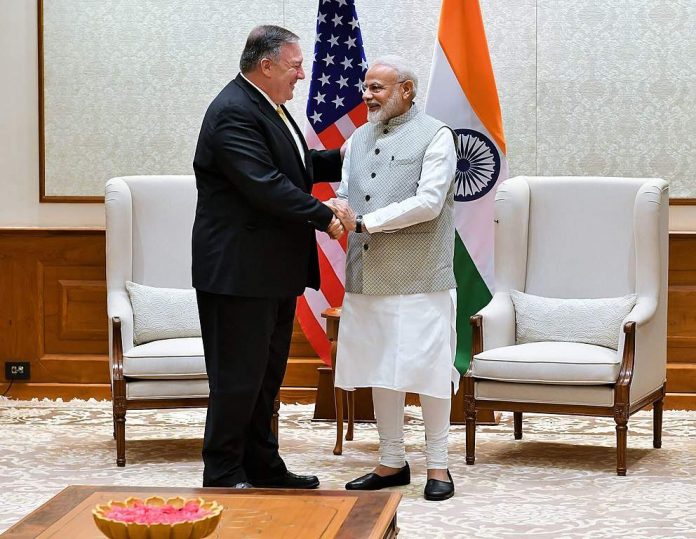The United States’ Secretary of State Mike Pompeo and Secretary of Defense Mark Esper are visiting India for third India-U.S. 2+2 Dialogue with their Indian counterparts on Oct. 27. This India-U.S. engagement comes at the time when accelerated efforts are taking place to formalize the Quadrilateral Security Dialogue or the Quad between India, the U.S., Japan and Australia. Earlier this month a meeting of the foreign ministers of the four proposed Quad members was held in Tokyo, Japan. In November, all the four countries will be participating in Malabar Naval Exercise.
Along with India, Pompeo will also visit the Maldives and Sri Lanka. The U.S.’ outreach to the South Asian nations comes at the time when India has also been reaching out to its neighbours especially Myanmar and the Maldives. It would be important to consider what the parallel outreach to India’s neighbourhood by India and the U.S. would mean in the context of Indo-Pacific and China.
India’s outreach to Myanmar and the Maldives
Myanmar as India’s territorial and maritime neighbour is a strategically important country for India. India-Myanmar relations were almost in a dormant position for a long period because of military rule in Myanmar. Only in the past few years the relations have started to warm up.
India’s engagements in Myanmar include development of India-Myanmar-Thailand Trilateral Highway and Kaladan Multi-Modal Transit Transport Project. India is also developing Sittwe Port in Rakhine province which is a part of Kaladan project. The Rohingya issue remains an important factor between both the countries as also the insurgents from India’s Northeastern states. Insurgency in India’s Northeast is a major security concern and many insurgent groups are based in Myanmar. Also China financing and arming the Arakan Army, an insurgent group of the Rohingyas, presents a security threat to Myanmar as well as India since the latter has invested in Sittwe Port which is located in the restive Rakhine province.
Recently India’s Chief of Army Staff and Foreign Secretary visited Myanmar in a bid to boost the bilateral relations. As a move to counter China, India also handed over a submarine to Myanmar.
The Maldives is another important strategic country for India as a neighbour and as a part of the Indo-Pacific. India’s relations with the Maldives have been on the upswing since past two years after Ibrahim Mohamed Solih became the president.
The growing proximity between India and the Maldives has been characterized by India’s participation in infrastructure projects in the Maldives, improving connectivity between both the countries and providing assistance to Male to fight COVID-19. The Maldives on its part has supported India’s position on Kashmir.
Countering China remains the dominant factor in India’s outreach to Myanmar and the Maldives and India has been approaching this challenge by way of two-pronged strategy. Increasing engagements allow India a base in these countries and thereby providing a further entry into the Indo-Pacific region. Secondly proximity with countries like Myanmar and the Maldives allows India to challenge China’s string of pearls that China intends to create to encircle India by engaging India’s neighbours.
What does the U.S.’ outreach signify?
Mike Pompeo’s visit to the Maldives comes on the heels of the defence cooperation agreement between the U.S. and Maldives signed in September. This agreement is intended to strengthen alliances in the Indo-Pacific in order to maintain peace and stability in the region, according to Pentagon.
Like India, the U.S. is looking to strengthen its ties with the Maldives with an eye on China. China has made huge investments in infrastructure projects in the country during the regime of former president Abdulla Yameen. The present government under Ibrahim Mohamed Solih has been reviewing these investments which are termed as debt-trap by the current Speaker of Parliament Mohamed Nasheed. The Maldives is also taking steps to reset its relations with China. The Maldives is considering scrapping of a free trade agreement with China so as to develop strong relations with other countries.
While focus on China is the principal driving factor for the U.S.’ outreach to the Maldives, radicalization is also a major challenge emerging from the archipelagic nation. Islamic radicalization in the country is a threat to India as well as the U.S. since the Maldives has been the country with one of the highest numbers of ISIS recruits on per capita basis. India and the U.S.’ close engagement with the Maldives would address the issues of radicalization and terrorism for stability in South Asia and with reference to the ISIS.
Sri Lanka presents a similar scenario. Ahead of his visit, Pompeo has urged Sri Lanka to rethink on its relations with China and consider building stable relations with the U.S. Over the past few years, China’s loans to Sri Lanka have been rising. Sri Lanka has been dependent on China for receiving finances for infrastructure projects as well as for fighting COVID-19. The rising debts had led Sri Lanka to lease its Hambantota Port to China for 99 years.
While India’s and the U.S.’ outreach to India’s neighbourhood has been parallel and not collective, it could indicate emerging situation. From India’s point of view, its ‘Neighbourhood First’ policy was upgraded to extended neighbourhood in order to reach out to Southeast Asian and Central Asian countries. As India is pursuing an outward looking policy by following an ASEAN centric approach to the Indo-Pacific, the U.S.’ engagements with South Asian nations provide an additional angle to India-U.S. cooperation. The past few years have witnessed a shrinking strategic presence of the U.S. in Southeast Asia and the Middle East. China’s aggressive maneuvering in South China Sea in recent times has caused the U.S. to increase its own military presence in the region.
The India-U.S. cooperation is mostly considered from the point of view of Indo-Pacific Region. At the time when efforts are being made to form the Quad, changing dynamics in South Asia, as a subset of the Indo-Pacific, could result in new avenues for cooperation between India and the U.S.
The views and opinions expressed in this article are those of the author.

The author is a Political Analyst and Researcher based in Vadodara, India.


